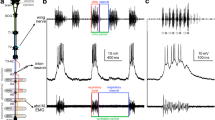Summary
Within the fifth abdominal segment of intact locusts a group of dorso-ventral expiratory muscles and one inspiratory antagonist display alternating ventilatory patterns of three basic types. Accelerated movements in the dorso-ventral plane are supported by isometric activity of the intersegmental muscles which prevent extensions in the longitudinal axis.
The intersegmental coupling of ventilatory motor patterns is strict during strong ventilation and loose and more metachronal with weaker pumping movements.
In resting animals ventilatory rhythms are discontinuous and the long intervening pauses are interrupted by miniature inspirations only. Pumping series have a tendency to prolong the later ventilatory cycles, and interfering rhythms of different pumping types occur. Low concentrations of atmospheric CO2 up to 3 % do not accelerate ventilatory rhythms.
Afferent activity from proprioceptors could be related to ventilatory motor bursts and stimulation of the sensory nerve produces inspiratory bursts via the segmental ganglion.
The neuronal mechanisms of synergistic and antagonistic muscle control as well as the segmental and intersegmental coordination and the effect of autonomous ganglionic oscillators in ventilation are discussed.
Similar content being viewed by others
References
Camhi, J. M., Hinkle, J.: Attentiveness to sensory stimuli: central control in locusts. Science175, 550–553, 553–556 (1972)
Campbell, J. I.: The anatomy of the nervous system of the mesothorax ofLocusta migrat. migratorioides R. and F. Proc. zool. Soc. London137, 403–432 (1961)
Case, J. F.: Median nerves and cockroach spiracular functions. J. Insect Physiol.1, 85–95 (1957)
Davis, W. J.: The neural control of swimmeret beating in the lobster. J. Exp. Biol.50, 99–117 (1969)
Farley, R. D., Case, J. F.: Sensory modulation of ventilative pacemaker output in the cockroachPeriplaneta americana. J. Insect Physiol.14, 591–601 (1968)
Farley, R. D., Case, J. F., Roeder, K. D.: Pacemaker for tracheal ventilation in the cockroachPeriplaneta americana. J. Insect Physiol.13, 1713–1728 (1967)
Fourtner, C. R., Drewes, C. D., Pax, R. A.: Rhythmic motor outputs coordinating the respiratory movement of the gill plates ofLimulus polyphemus. Comp. Biochem. Physiol.38a, 751–762 (1971)
Fraenkel, G.: Untersuchungen über die Koordination von Reflexen und automatischnervösen Rhythmen bei Insekten. II. Die nervöse Regelung der Atmung während des Fluges. III. Das Problem des gerichteten Atemstromes in den Tracheen der Insekten. IV. Über die nervösen Zentren der Atmung und die Koordination ihrer Tätigkeit. Z. vergl. Physiol.16, 394–417, 418–443, 444–461 (1932)
Guthrie, D. M. G.: Control of the ventral diaphragm in an insect. Nature196, 531–532 (1952)
Hoyle, G.: The neuromuscular mechanism of an insect spiracle. J. Insect Physiol.3, 378–394 (1959)
Huber, F.: Untersuchungen zur nervösen Atmungsregulation der Orthopteren (Saltatoria: Gryllidae). Z. vergl. Physiol.43, 341–359 (1960)
Hughes, G. M., Wiersma, C. A. G.: The coordination of swimmeret movements in the crayfish,Procambarus clarkii (Girard). J. Exp. Biol.37, 637–670 (1960)
Hustert, R.: Morphologie und Atmungsbewegungen des 5. Abdominalsegmentes vonLocusta migratoria migratorioides. Zool. Jb. Physiol.78, 157–174 (1974)
Kestler, P.: Die diskontinuierliche Ventilation beiPeriplaneta americana und anderen Insekten. Dissertation, Würzburg (1971)
Lewis, G. W., Miller, P. L., Mill, P. S.: Neuro-muscular mechanisms of abdominal pumping in the Locust. J. exp. Biol.59, 149–168 (1973)
Miller, P. L.: Respiration in the desert locust. I. The control of ventilation, J. Exp. Biol.37, 224–236 (1960a)
Miller, P. L.: Respiration in the desert locust. II. The control of the spiracles. J. Exp. Biol.37, 224–236 (1960b)
Miller, P. L.: Respiration of the desert locust. III. Ventilation and the spiracles during flight. J. Exp. Biol.37, 264–278 (1960c)
Miller, P. L.: The central nervous control of respiratory movements. In: The Physiology of the Insect Central Nervous System (J. E. Treherne, L. W. L. Beament, eds.)3, 141–155 (1965)
Miller, P. L.: The derivation of the motor command to the spiracles of locust. J. Exp. Biol.46, 349–371 (1967)
Miller, P. L.: Rhythmic activity in the insect nervous system: thoracic ventilation in nonflying beetles. J. Insect Physiol.17, 395–405 (1971)
Miller, P. L.: Rhythmic activity in the insect nervous system. II. Sensory and electrical stimulation of ventilation in a mantid. J. Exp. Biol.54, 599–607 (1971)
Myers, T. H., Retzlaff, E.: Localization and action of the respiratory centre of the Cuban Burrowing cockroach. J. Insect Physiol.9, 607–614 (1963)
Paul, D. H.: Swimming behavior of the sand crab,Emerita analoga (Crustacea, Anomura). I. Analysis of the uropod stroke. Z. vergl. Physiol.75, 233–258 (1971)
Pickard, R. S., Mill, P. J.: Ventilatory muscle activity in intact preparations of Aeschnid dragonfly larvae. J. Exp. Biol.56, 527–536 (1972)
Plateau, F.: Recherches experimentales sur les mouvements respiratoires des insectes. Mém. Acad. Roy. Belg.45, 219ff (1882)
Slifer, E. H., Finlayson, L. H.: Muscle receptor organs in grasshoppers and locusts. Quart. J. microscop. Sci.97, 617–620 (1956)
Snodgrass, R. E.: The abdominal mechanisms of a grasshopper. Smith. Misc. Coll.94, 1–89 (1935)
Stein, P. S. G.: Intersegmental coordination of swimmeret motoneuron activity in crayfish. J. Neurophysiol.34, 310–318 (1971)
Tyrer, N. M.: Innervation of the abdominal intersegmental muscles in the grasshopper, II. Physiological analysis. J. Exp. Biol.55, 315–324 (1971)
Watts, D. T.: Intratracheal pressure in insect respiration. Ann. ent. Soc. Amer.44, 527–528 (1951)
Weevers, R. de G.: The physiology of a lepidopteran muscle receptor. I. The sensory response to stretch. J. Exp. Biol.44, 177–194 (1966)
Weis-Fogh, T.: Biology and physics of locust flight. VIII. Lift and metabolic rate of flying locusts. J. Exp. Biol.41, 257–272 (1964)
Wiersma, C. A. G., Ikeda, K.: Interneurones commanding swimmeret movements in the crayfish,Procambarus clarkii (Girard). Comp. Biochem. Physiol.12, 509–525 (1964)
Wyse, G. A.: Intracellular and extracellular motor neuron activity underlying rhythmic respiration inLimulus, J. Comp. Physiol.81, 259–276 (1972)
Author information
Authors and Affiliations
Rights and permissions
About this article
Cite this article
Hustert, R. Neuromuscular coordination and proprioceptive control of rhythmical abdominal ventilation in intactLocusta migratoria migratorioides . J. Comp. Physiol. 97, 159–179 (1975). https://doi.org/10.1007/BF00645359
Received:
Issue Date:
DOI: https://doi.org/10.1007/BF00645359




